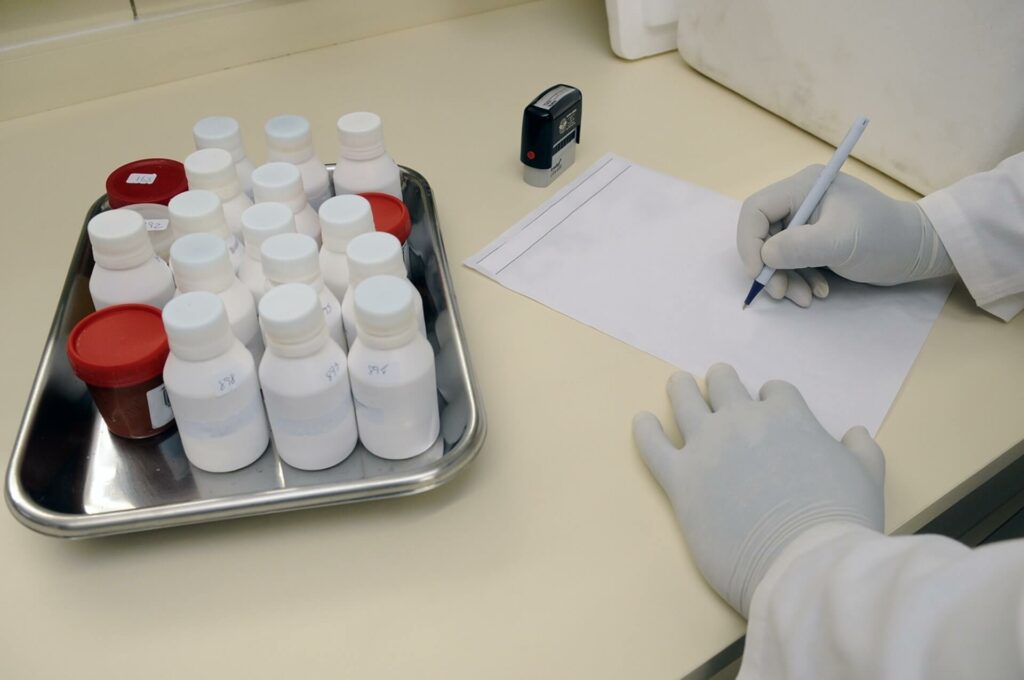Good Laboratory Practice (GLP) is a set of criteria used to ensure quality assurance in non-clinical studies. GLP principles are concerned with the organisational processes by which studies are planned, performed, monitored, recorded, reported and archived.
These guidelines are intended to support the integrity of safety testing data for products regulated by government agencies. GLP is commonly applied in the pharmaceutical industry. In pharmaceuticals, Good Laboratory Practice principles apply to the pre-clinical stages of drug development and clinical pharmacology.
Good Laboratory Practices also apply outside of the pharmaceutical industry. Most commonly for non-pharmaceutical agents including food additives, packaging and medical devices.
This article covers everything you need to know about Good Laboratory Practices, from when these regulations are required, to how they should be managed in studies.
Find our more about our central lab services or bioanalytical laboratory services.
What is the purpose of Good Laboratory Practices?
In clinical pharmacology, the main aim of Good Laboratory Practice is to ensure that all drugs being tested for safety during non-clinical stages follow a quality management process before approval for human use in clinical trials.
This ensures that stringent safety standards are followed prior to human testing, preventing participants from potential harm during First-In-Human trial stages.
Good Laboratory Practices are in place to make sure that all written procedures are followed during non-clinical research. This helps control external factors that could impact the reliability of safety data used to approve drugs for clinical research.
When is GLP required?
GLP regulations are applied in the UK, US and EU. They are required for non-clincal safety, toxicology and pharmaceutical studies that have been proposed for human applications.
These guidelines were established by the Organisation for Economic Co-Operation and Development (OECD). GLP is only required in non-clinical studies and testing, and does not apply to later clinical stages of research.
For instance, GLP would apply to pre-clinical research stages, where drugs are tested on animal or cell subjects before they are approved for clinical testing with human participants.
Following this, clinical stages of research are governed by Good Clinical Practices (GCP), which are intended to keep human participants safe during the study process.
Often, GLP is applied where it is not necessary. It is important to distinguish the difference between the different practice regulations required at different stages of clinical research.
GCP vs GLP
The main difference between GCP and GLP is their applications. Good Laboratory Practice (GLP) applies to pre-clinical drug safety testing, whereas Good Clinical Practice (GCP) is applied across the whole clinical research process.
GCP and GLP are both inspected by the Food and Drug Administration (FDA), used to ensure safety and quality throughout the non-clinical and clinical research process.
What are the Good Laboratory Practice (GLP) guidelines?
In order to comply with GLP, it is important that studies are conducted in line with the following guidelines.
Personnel
Prior to the research taking place, there must be an appointed study director whose responsibility is to conduct and oversee the study’s GLP compliance and budget. This must be accompanied by a separate Quality Assurance Unit (QAU) that is independent of the testing facility organisation.
This ensures that the study has dedicated personnel to monitor and manage GLP compliance.
Study plan
The study plan should outline master guidelines that detail how the study will be conducted. This should outline the stages of the study, and general time schedules for each stage. It should also cover the methods and materials that will be used in the research.
Sometimes referred to as a study protocol, the plan must undergo approval and review before the study can begin. The protocol is prepared by the study director, who discusses the plan details with other research staff before approval.
The study plan is then reviewed by the Quality Assurance Unit, who assesses its compliance with Good Laboratory Practice.
Standard operating procedures
Standard operating procedures (SOP) outline step-by-step instructions that provide methods for carrying out routine operations in laboratory and clinical settings. These procedures help improve efficiency, quality output and communication.
These procedure guidelines are not limited to GLP alone, they cover other aspects of the overall research, such as pharmacovigilance.
SOPs must outline all Good Laboratory Practices, giving staff clear activities to follow. This should cover:
- Equipment guidelines
- Testing items
- Record keeping, reporting and storage
- Biological test systems
- Testing and analysis procedures
- Computer system guidelines
- Quality assurance procedures
Facility, equipment and handling
In line with Good Laboratory Practices, facility managers and workers must follow specific processes when dealing with facility and test equipment.
It is important to ensure that all facility equipment is kept separate as appropriate, with areas labelled, and equipment cleaned regularly. This helps improve safety and workflow, and helps all personnel understand laboratory procedures when using central laboratory facilities.
Facility workers must keep records of the date of receipt and expiry for test and control items, as well as specific storage instructions. The identity, purity, composition and stability of test and control items should also be recorded and labelled.
Additionally, workers should record the quantity received and quantity used when handling test items.
Study reports
The study director is also responsible for the study report, an essential part of medical writing. The final study report should outline a detailed and accurate discussion of the study and its conduct, detailing any deviation from the original Standard Operating Procedures or study plan.
The final report should also contain the results of the research, with a critical discussion of scientific conclusions. Lastly, the study report should provide a GLP Compliance Statement.
Study records
Good Laboratory Practice principles require data “to be retained in archives for the period specified by the appropriate regulatory authorities”, according to Schedule 1 of the UK GLP Regulations.
This includes the retention of the study plan, raw data, samples, reference items specimens and the final report. Record retention is important, since the Quality Assurance Unit inspector conducting the GLP inspection will rely on this data to assess whether the study complied with GLP.
Good Laboratory Practice examples
Common examples of GLP principles include:
- Wearing PPE
- Communicating frequently with all personnel in the laboratory
- Attending to unfamiliar smells or materials
- Cleaning equipment regularly
- Labelling workspaces
- Avoiding working alone
- No food or drink
CRO services
As a full service CRO, we offer integrated central laboratory services to support clinical development needs. We are experts in regulatory affairs, helping support your strategy with GLP and other regulatory compliance processes to aid fast study approvals. Speak to our team to get started.





